 AP Biology students from Cardinal Wuerl North Catholic High School visited the Department of Structural Biology at the University of Pittsburgh. Students were led on a tour by Dr. Rieko Ishima, an associate professor and a principal investigator in the department. Dr. Ishima oversees a team of research associates and fellows who are currently working to determine protein structure and dynamics using nuclear magnetic resonance.
AP Biology students from Cardinal Wuerl North Catholic High School visited the Department of Structural Biology at the University of Pittsburgh. Students were led on a tour by Dr. Rieko Ishima, an associate professor and a principal investigator in the department. Dr. Ishima oversees a team of research associates and fellows who are currently working to determine protein structure and dynamics using nuclear magnetic resonance.
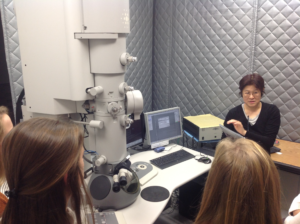
Protein images are beyond tiny! The nuclear magnetic resonance spectroscopy of proteins does not ‘take a picture.’ Rather, it relies on complex mathematical calculations to build a three dimensional image of the protein.
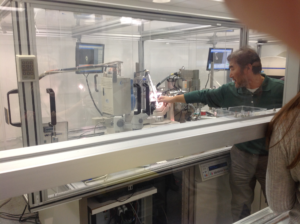 During Dr. Ishima’s tour, students were shown various equipment used in cryo-electron microscopy, nuclear magnetic resonance, and x-ray crystallography. Students were fascinated not only by the incredible detail achieved in the digital images produced by nuclear magnetic resonance (NMR), but also by the sheer size of the equipment required to generate those results.
During Dr. Ishima’s tour, students were shown various equipment used in cryo-electron microscopy, nuclear magnetic resonance, and x-ray crystallography. Students were fascinated not only by the incredible detail achieved in the digital images produced by nuclear magnetic resonance (NMR), but also by the sheer size of the equipment required to generate those results.
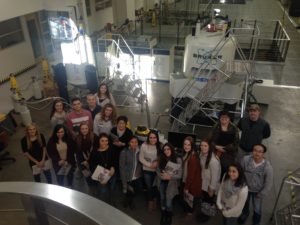 Though NMR examines molecular structure and dynamics at the atomic level, the spectrometers required to view particles that small are extremely large. Pitt has seven spectrometers in this department, and they are housed in 10,000 square foot laboratory. The students were amazed to learn that when the spectrometers were delivered, the first floor windows were removed to allow the equipment to be lowered into the NMR lab! We are standing in front of a two magnets that had to be lowered by crane through an open window.
Though NMR examines molecular structure and dynamics at the atomic level, the spectrometers required to view particles that small are extremely large. Pitt has seven spectrometers in this department, and they are housed in 10,000 square foot laboratory. The students were amazed to learn that when the spectrometers were delivered, the first floor windows were removed to allow the equipment to be lowered into the NMR lab! We are standing in front of a two magnets that had to be lowered by crane through an open window.
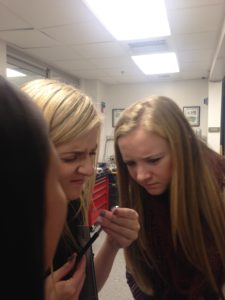 Students were also able to tour the cryo-electron microscope facility, where three electron microscopes allow researchers to engage in structural analysis of proteins, viruses, cellular organelles and bacterial cells. Finally, Dr. Ishima and her team led students to the x-ray crystallography lab. Here, researchers are able to grow, store, and monitor crystals. Once crystals are ready for analysis, x-ray beams and image plate detectors are used to collect data about protein structures at the atomic level. While scientists in the lab often use tiny tools to manually transfer crystals for analysis, the lab also is equipped with a robot that can mount and collect data from up to 80 crystals for rapid analysis.
Students were also able to tour the cryo-electron microscope facility, where three electron microscopes allow researchers to engage in structural analysis of proteins, viruses, cellular organelles and bacterial cells. Finally, Dr. Ishima and her team led students to the x-ray crystallography lab. Here, researchers are able to grow, store, and monitor crystals. Once crystals are ready for analysis, x-ray beams and image plate detectors are used to collect data about protein structures at the atomic level. While scientists in the lab often use tiny tools to manually transfer crystals for analysis, the lab also is equipped with a robot that can mount and collect data from up to 80 crystals for rapid analysis.
The field is extraordinary.
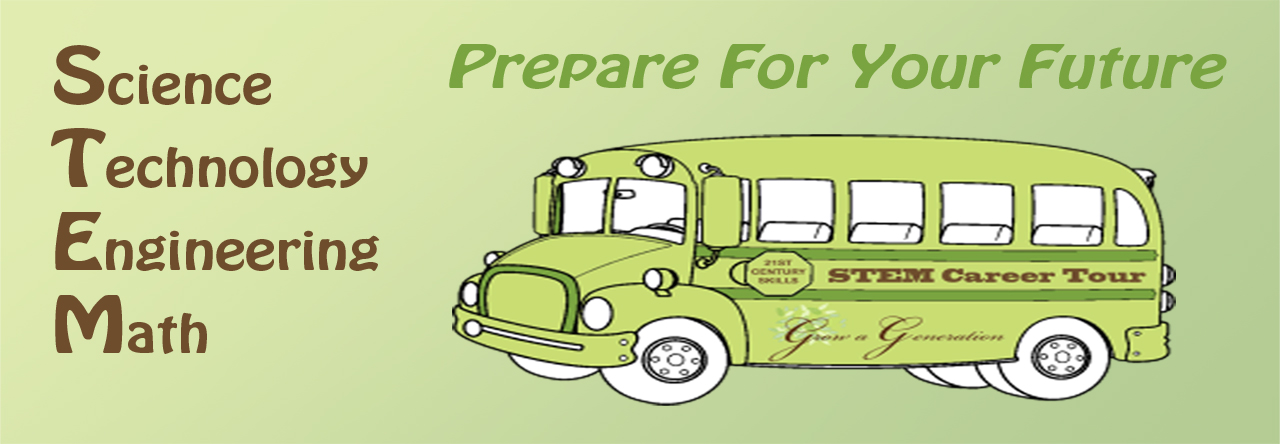
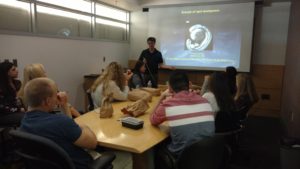 On November 18, 2016, AP Biology students from Cardinal Wuerl North Catholic High School participated in a STEM Careers Tour which included a visit to the Department of Developmental Biology at the University of Pittsburgh. Specifically, students were able to interact with Dr. Michael Tsang, an associate professor who is currently conducting research in Pitt’s zebrafish aquaria. In the zebrafish facility, one of the largest in the world, researchers are engaging in multiple large-scale projects which use the zebrafish to understand how organs such as the liver, kidney and heart develop in the embryo.
On November 18, 2016, AP Biology students from Cardinal Wuerl North Catholic High School participated in a STEM Careers Tour which included a visit to the Department of Developmental Biology at the University of Pittsburgh. Specifically, students were able to interact with Dr. Michael Tsang, an associate professor who is currently conducting research in Pitt’s zebrafish aquaria. In the zebrafish facility, one of the largest in the world, researchers are engaging in multiple large-scale projects which use the zebrafish to understand how organs such as the liver, kidney and heart develop in the embryo.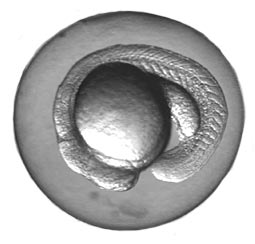 The visit began with a presentation by Dr. Tsang, during which he explained his research and the benefits of experimenting with zebrafish. Students learned that zebrafish are ideal subjects for experimentation because they are small and easily maintained, embryos are transparent and easily visualized during development, and they are able to repair and regenerate damaged tissue. All of the students were fascinated when they learned that, after a few weeks at the bottom of the tank, zebrafish that have sustained a severed spinal cord are able to repair the damage and regain mobility!
The visit began with a presentation by Dr. Tsang, during which he explained his research and the benefits of experimenting with zebrafish. Students learned that zebrafish are ideal subjects for experimentation because they are small and easily maintained, embryos are transparent and easily visualized during development, and they are able to repair and regenerate damaged tissue. All of the students were fascinated when they learned that, after a few weeks at the bottom of the tank, zebrafish that have sustained a severed spinal cord are able to repair the damage and regain mobility! After this presentation, students were able to experience a tour of the zebrafish aquaria, which contains over 11,000 tanks housing over 500,000 zebrafish. While touring the facility, students asked a wide variety of questions about the logistics in place to maintain such a large research lab, and they learned that while the tanks are self-cleaning, university employees spend several hours each day feeding the fish. The rows of tanks with tiny, newly-hatched fish were a highlight of the tour, but the students were most intrigued by the fluorescent green zebrafish. These genetically modified fish carry the gene for Green Fluorescent Protein (GFP), which allows researchers to better identify abnormalities, such as those that lead to Alzheimer’s Disease.
After this presentation, students were able to experience a tour of the zebrafish aquaria, which contains over 11,000 tanks housing over 500,000 zebrafish. While touring the facility, students asked a wide variety of questions about the logistics in place to maintain such a large research lab, and they learned that while the tanks are self-cleaning, university employees spend several hours each day feeding the fish. The rows of tanks with tiny, newly-hatched fish were a highlight of the tour, but the students were most intrigued by the fluorescent green zebrafish. These genetically modified fish carry the gene for Green Fluorescent Protein (GFP), which allows researchers to better identify abnormalities, such as those that lead to Alzheimer’s Disease.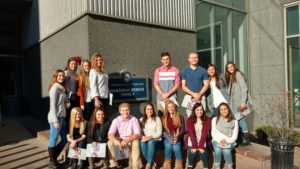 Most importantly, students engaged in dialogue with Dr. Tsang about both the benefits and ethical obligations of animal testing. The visit to the lab, and particularly this conversation with Dr. Tsang, ignited a desire in many of the students to pursue ongoing research with zebrafish. Sixteen AP Biology students from Cardinal Wuerl North Catholic are preparing experimentation results currently being conducted with both adult and embryonic zebrafish for entry into the Pittsburgh Regional Science and Engineering Fair! Mrs. Murray classroom is becoming its own zebrafish aquaria and the contacts she made on the tour have become mentors in her ongoing efforts to make biology come to life for all her students.
Most importantly, students engaged in dialogue with Dr. Tsang about both the benefits and ethical obligations of animal testing. The visit to the lab, and particularly this conversation with Dr. Tsang, ignited a desire in many of the students to pursue ongoing research with zebrafish. Sixteen AP Biology students from Cardinal Wuerl North Catholic are preparing experimentation results currently being conducted with both adult and embryonic zebrafish for entry into the Pittsburgh Regional Science and Engineering Fair! Mrs. Murray classroom is becoming its own zebrafish aquaria and the contacts she made on the tour have become mentors in her ongoing efforts to make biology come to life for all her students.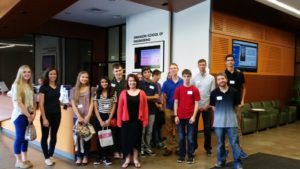 On Monday, June 13, 2016, we began our STEM Careers Tour with a visit to University of Pittsburgh’s Department of Chemistry and Petroleum. Students gathered in a conference room for a brief introductory presentation. While we ate our lunch, four graduate students studying chemical engineering described what a chemical engineer is, and how they differ from a chemist. There are a few main differences between the two occupations: novelty, scale, and sample size.
On Monday, June 13, 2016, we began our STEM Careers Tour with a visit to University of Pittsburgh’s Department of Chemistry and Petroleum. Students gathered in a conference room for a brief introductory presentation. While we ate our lunch, four graduate students studying chemical engineering described what a chemical engineer is, and how they differ from a chemist. There are a few main differences between the two occupations: novelty, scale, and sample size. 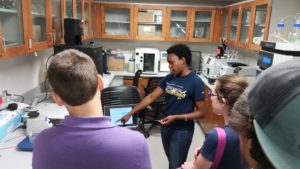 Novelty of products is the first difference. A chemist will use more original thinking to create a new product from scratch, while a chemical engineer refines a product to make it more efficient and consumer friendly. Another disparity between the two is the scale of production. Chemical engineers work on a large scale, like a factory. On the other hand, chemists work on a much smaller scale. This ties into the last difference, sample size. While chemists work with only a few grams, chemical engineers work with tons. After learning the basics, the students were shown the broad range of career opportunities available in chemical engineering and that in order to have the skills “to do cutting edge research,” you need an advanced degree. You “earn the right to think originally” once you’ve earned your Ph.D.
Novelty of products is the first difference. A chemist will use more original thinking to create a new product from scratch, while a chemical engineer refines a product to make it more efficient and consumer friendly. Another disparity between the two is the scale of production. Chemical engineers work on a large scale, like a factory. On the other hand, chemists work on a much smaller scale. This ties into the last difference, sample size. While chemists work with only a few grams, chemical engineers work with tons. After learning the basics, the students were shown the broad range of career opportunities available in chemical engineering and that in order to have the skills “to do cutting edge research,” you need an advanced degree. You “earn the right to think originally” once you’ve earned your Ph.D.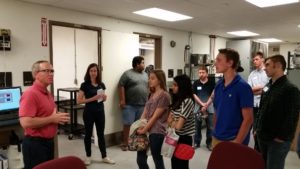 After the introduction, the students headed downstairs to the Unit Operations Lab. Here they were able to meet with a professor who described and performed demonstrations using the lab equipment. He invited students to help him perform experiments with his equipment. One machine showed the reactions taking place to produce soap. The display had line graphs showing whether it was exothermic or endothermic, and if the reaction was at a steady state. The professor also explained that there are four important skills to succeed in industry: equipment, report writing, presentation, and working in groups. The Unit Operations Lab demonstrated how processes are started on a small scale so they can later be scaled up.
After the introduction, the students headed downstairs to the Unit Operations Lab. Here they were able to meet with a professor who described and performed demonstrations using the lab equipment. He invited students to help him perform experiments with his equipment. One machine showed the reactions taking place to produce soap. The display had line graphs showing whether it was exothermic or endothermic, and if the reaction was at a steady state. The professor also explained that there are four important skills to succeed in industry: equipment, report writing, presentation, and working in groups. The Unit Operations Lab demonstrated how processes are started on a small scale so they can later be scaled up. 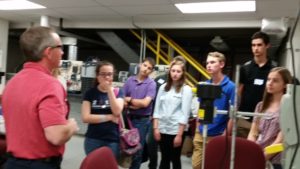 Once the tour of the Unit Operations Lab concluded, students split up into four groups to tour the Little Lab, Banerjee Lab, Veser Lab, and the 11th Floor Computational Labs. At the Little Lab, they often study Biomimetic strategies. The use of synthetic material helps imitate biological interactions and properties. The Little Lab also focuses on controlling deliveries for creating more efficient medicine. For example, instead of taking a pain killer that would send signals all over a person’s body, one could simply take medicine that targets a specific cell, providing more relief and efficiency.
Once the tour of the Unit Operations Lab concluded, students split up into four groups to tour the Little Lab, Banerjee Lab, Veser Lab, and the 11th Floor Computational Labs. At the Little Lab, they often study Biomimetic strategies. The use of synthetic material helps imitate biological interactions and properties. The Little Lab also focuses on controlling deliveries for creating more efficient medicine. For example, instead of taking a pain killer that would send signals all over a person’s body, one could simply take medicine that targets a specific cell, providing more relief and efficiency. 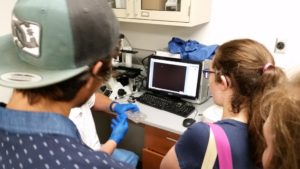 The Veser Lab had lots of equipment in it for its work with nanomaterials – including a scale and a machine that could detect the chemical makeup of a product. In the Computational Labs, where the hypothetical is modeled with computer simulations, the students met some of the college students and learned about what they were studying and researching. One of the materials that the students had discovered was metal organic framework. When it is created, it forms unique and complicated structures. The students are finding ways to utilize this new material.
The Veser Lab had lots of equipment in it for its work with nanomaterials – including a scale and a machine that could detect the chemical makeup of a product. In the Computational Labs, where the hypothetical is modeled with computer simulations, the students met some of the college students and learned about what they were studying and researching. One of the materials that the students had discovered was metal organic framework. When it is created, it forms unique and complicated structures. The students are finding ways to utilize this new material.